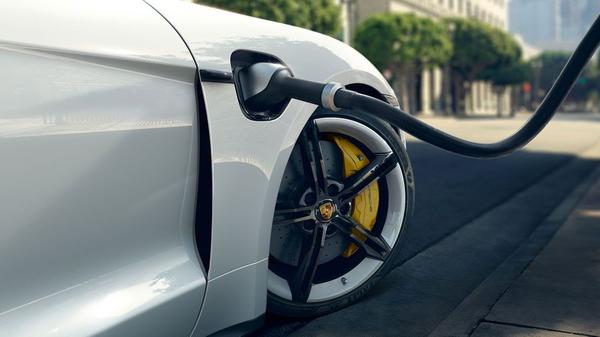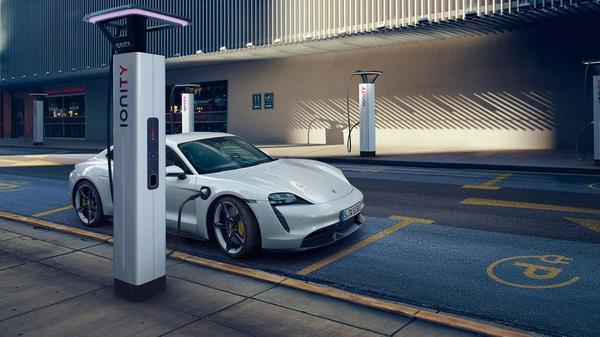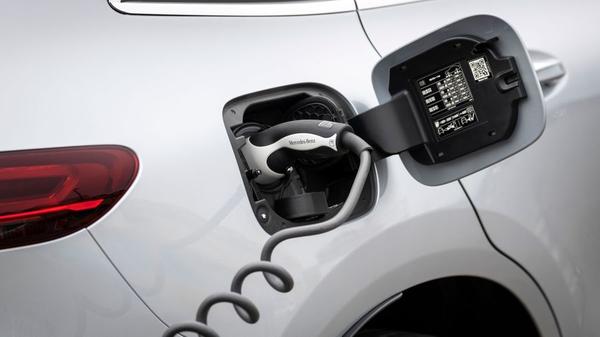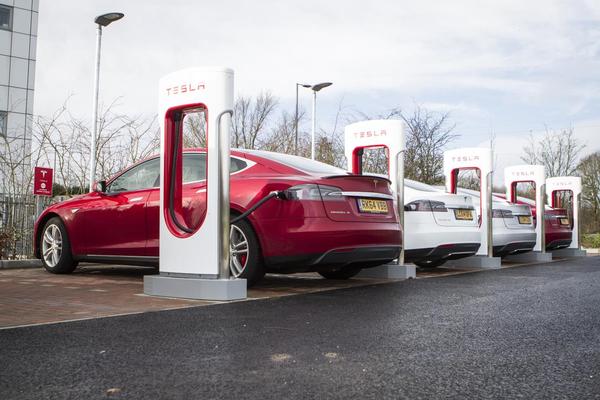Advice
Electric Car Charging Points: Charging On The Go
Can you take an electric car on a road trip? Yes you can. Here’s everything you need to know about public charging, why it’s really nothing to worry about, and why the ever-growing charging network is making ‘range anxiety’ a thing of the past.


Words by: Andrew Woodhouse
Last updated on 9 January 2026 | 0 min read
Electric car owners should do most of their day-to-day charging at home or work, where the cost per unit is generally much lower, but the UK charging network provides a huge number of locations to top up.
Using a public charging station is very often just as easy as using a fuel pump – park up, plug in, tap your bank card and you’re all set. In this article, we’ll take a look at the national and regional charging network providers, how they work, and which apps, cards or subscriptions might be useful to help you along the way.
Using a public charging station is very often just as easy as using a fuel pump – park up, plug in, tap your bank card and you’re all set. In this article, we’ll take a look at the national and regional charging network providers, how they work, and which apps, cards or subscriptions might be useful to help you along the way.
How do electric car charging points work?
Just like needing to know if your car is petrol or diesel when you pull up at the fuel station, there are a few things to know about your electric car when looking for a public charger.
Before you choose which charger to drive to, make sure you know which connectors your car is compatible with. Most cars will have a Type 2 connector used for slower charging speeds. Additionally, for rapid charging, they might also have a Combined Charging System (CCS) or CHAdeMO port, although the latter is rare. Click here for a full explanation of charging cable types. Fast chargers (typically 7-22kW) will usually require you to use your own ‘Type 2’ cable, whereas rapid charging points (50kW and above) will have a ‘tethered’ cable attached to the unit – you simply plug the cable into your car’s CCS or CHAdeMO port. Although some chargers have multiple cables with different connectors, many of the newer fast chargers just have CCS. You can check in advance by looking at the provider’s website or using an app like Zap Map. Once you’ve located a suitable charger, there are a few ways to confirm payment and start your charging session. These vary by provider but include apps, Radio-frequency identification (RFID) cards and contactless card payments, more this below.
Before you choose which charger to drive to, make sure you know which connectors your car is compatible with. Most cars will have a Type 2 connector used for slower charging speeds. Additionally, for rapid charging, they might also have a Combined Charging System (CCS) or CHAdeMO port, although the latter is rare. Click here for a full explanation of charging cable types. Fast chargers (typically 7-22kW) will usually require you to use your own ‘Type 2’ cable, whereas rapid charging points (50kW and above) will have a ‘tethered’ cable attached to the unit – you simply plug the cable into your car’s CCS or CHAdeMO port. Although some chargers have multiple cables with different connectors, many of the newer fast chargers just have CCS. You can check in advance by looking at the provider’s website or using an app like Zap Map. Once you’ve located a suitable charger, there are a few ways to confirm payment and start your charging session. These vary by provider but include apps, Radio-frequency identification (RFID) cards and contactless card payments, more this below.
Different charging speeds
Something to bear in mind is that the power listed on the charging unit (in kW) will reflect the maximum possible output. The speed your car actually charges at will depend on external factors and the car itself. Most electric cars will slow down their rate of charge beyond 80 percent to protect the battery, for instance. Here’s how charging speeds are classified: • Slow (3-6kW) Slow charging is essentially plugging your car into a three-pin domestic socket, which is possible if you have the right cable, but not advisable unless absolutely necessary. • Fast (7kW to 49kW) Most home-installed EV chargers (“wall boxes”) will run at 7kW speed and use a Type 2 cable. This is the best (and most common) way of keeping your electric car charged. It’s possible to get electricity tariffs that are cheaper off-peak to encourage overnight EV charging. You’ll often find public chargers that run at up to 22kW, which is still categorised ‘fast’. • Rapid (50kW to 149kW) Rapid charging adds a boost to your car’s battery in a shorter period of time, taking advantage of the maximum rate of charge that your EV is capable of. Rapid chargers are generally found at motorway service stations and tend to have a high cost per unit of electricity compared to slower chargers. • Ultra-rapid (150kW and above) These are even faster than rapid chargers, but the principle is the same, providing a decent top up in a matter of minutes. Only the the most modern (and expensive) electric cars can charge at this sort of rate at the moment, but the tech is advancing all the time. The vast majority of new electric cars are capable of rapid charging, but it’s worth double checking. Wondering which one to use when you're out on the road? Here's slow, fact and rapid charging points, simplified.How many electric car charging points are there?
There are currently over 75,000 public charging points in the UK, with this number growing all the time. These chargers are available at service stations, car parks, roadsides and supermarkets.
Where does the power come from?
Power to charge the electric cars comes from the National Grid, who have said “the power system could cope with an overnight boom in electric vehicles”. As the number of electric vehicles on the road is steadily increasing, the system will have plenty of time to grow in line with demand.

How much do electric car charging points cost?
This depends, but generally rapid charging points are more expensive than slow and fast charging points. The cost is usually calculated per kilowatt hour (kWh). There are some charging points, like Zero Carbon World’s, that are free to use. However, if you can charge from home this will be the most cost-effective way to top up.
A couple of network providers may charge additional fees, so keep an eye out for things like: • A one-off registration fee, which is normally around £10 or £20 • A monthly subscription fee • A connection fee, which can be between 50p to £3 There may also be a cost per hour to charge, which is primarily used to discourage people leaving their cars plugged in all day. So, make sure to check how long you are allowed to stay and whether there are any additional parking charges.
A couple of network providers may charge additional fees, so keep an eye out for things like: • A one-off registration fee, which is normally around £10 or £20 • A monthly subscription fee • A connection fee, which can be between 50p to £3 There may also be a cost per hour to charge, which is primarily used to discourage people leaving their cars plugged in all day. So, make sure to check how long you are allowed to stay and whether there are any additional parking charges.
National and regional charging networks
UK charging points are owned and run by several different companies, called network providers. Think of charging point networks like phone networks: different providers offer access to the same thing for slightly different prices and packages. You just need to pick the one that gives you the best coverage in your area.
There are many national network providers, who own and run charging points across the UK, like Shell Recharge, InstaVolt , Osprey, GRIDSERVE, BP Pulse and Pod Point. There are also regional network providers, who will cover local areas. You can use sites like Plugshare or Zap Map to find regional networks in your area, or an area you plan on visiting. This could be particularly handy if you don’t have a home charger and might need to rely on public charging points more regularly. It’s worth doing a bit of research on who runs the charging points near you. You can just pull up and use most public charging points, but some do require you to become a member of a charging point network. If you do have to sign up, you’ll get access to all their charging points. It’s becoming increasingly common for networks to partner together, allowing you to use one app to access multiple providers. It’s worth checking, as the chances are you might already have a membership that will cover you. Networks vary in size, cost and the services they offer. Most offer slow, fast, rapid or ultra-rapid charging options so you’ll get the choice of a quick top-up whilst out on the road, or a full charge if you’re likely to be parked for some time. Outside of national and regional charging networks, you have a couple of other options: • If you’re driving a Tesla, you can use its dedicated Supercharger stations. In 2023 these became available to other vehicles too. • Some local authorities also offer public charging points, with government grant schemes funding them around the country. You can check with your local council to find out where points are located near you.
There are many national network providers, who own and run charging points across the UK, like Shell Recharge, InstaVolt , Osprey, GRIDSERVE, BP Pulse and Pod Point. There are also regional network providers, who will cover local areas. You can use sites like Plugshare or Zap Map to find regional networks in your area, or an area you plan on visiting. This could be particularly handy if you don’t have a home charger and might need to rely on public charging points more regularly. It’s worth doing a bit of research on who runs the charging points near you. You can just pull up and use most public charging points, but some do require you to become a member of a charging point network. If you do have to sign up, you’ll get access to all their charging points. It’s becoming increasingly common for networks to partner together, allowing you to use one app to access multiple providers. It’s worth checking, as the chances are you might already have a membership that will cover you. Networks vary in size, cost and the services they offer. Most offer slow, fast, rapid or ultra-rapid charging options so you’ll get the choice of a quick top-up whilst out on the road, or a full charge if you’re likely to be parked for some time. Outside of national and regional charging networks, you have a couple of other options: • If you’re driving a Tesla, you can use its dedicated Supercharger stations. In 2023 these became available to other vehicles too. • Some local authorities also offer public charging points, with government grant schemes funding them around the country. You can check with your local council to find out where points are located near you.

How to pay for electric car charging points
Some network providers offer annual subscriptions, some accept contactless payments, and some use apps or pre-paid RFID cards.
Contactless payments
Lots of charging networks accept contactless payments, including leading network providers like Instavolt, Osprey and Shell Recharge (who also have an app, more on which in a moment). This makes charging your EV as simple as going to a self-serve fuel station.
A change to UK law in 2023 established that contactless payments must be available on all new public charging points with 8kW power or above. Existing rapid charging points will also need to be updated to accept contactless payments. Paying with contactless is easy, you simply tap your contactless card to start, and payment will automatically be taken once you’ve finished charging. The provider may take a ‘pre-authorisation’ fee before starting the charge. The amount taken can vary but will be returned, so you only pay for the energy you use. Some providers provide price incentives for signing up to their apps or subscription services, so it’s worth looking into these; paying ad hoc by card at a rapid or ultra-rapid charger is often the most expensive way of charging an electric car.
A change to UK law in 2023 established that contactless payments must be available on all new public charging points with 8kW power or above. Existing rapid charging points will also need to be updated to accept contactless payments. Paying with contactless is easy, you simply tap your contactless card to start, and payment will automatically be taken once you’ve finished charging. The provider may take a ‘pre-authorisation’ fee before starting the charge. The amount taken can vary but will be returned, so you only pay for the energy you use. Some providers provide price incentives for signing up to their apps or subscription services, so it’s worth looking into these; paying ad hoc by card at a rapid or ultra-rapid charger is often the most expensive way of charging an electric car.
Apps
Apps can be accessed by a smartphone. Features will vary, but most will allow you to pay for charging, manage your usage, and will also show you charge point locations and details.
Best apps for UK charge points
Take a look at which providers are popular in your area, and which ones operate a good number of charging points near you. On a national level, you’ll probably get good coverage from a combination of these apps:
• BP Pulse • Genie Point • Shell Recharge • InstaVolt There is an increasing number of apps that provide access to multiple networks all in one place, so you only need to sign up once. Some examples include: • Bonnet • Chargepoint • Zap Pay • Octopus Electroverse Most other national network providers can be accessed and paid for online (using a smartphone) or accept contactless payments.
• BP Pulse • Genie Point • Shell Recharge • InstaVolt There is an increasing number of apps that provide access to multiple networks all in one place, so you only need to sign up once. Some examples include: • Bonnet • Chargepoint • Zap Pay • Octopus Electroverse Most other national network providers can be accessed and paid for online (using a smartphone) or accept contactless payments.
RFID card
RFID cards (Radio Frequency Identification) are pre-paid cards that allow access to charge points. They’re easy to use, and don’t rely on a strong internet signal to work. You might want to sign up to a few.
Best RFID cards for charge points
Again, this will depend where you live, so take a look online and ask around.
Nationally, two of the biggest charging networks, Shell Recharge and BP Pulse, both offer RFID card options.
Nationally, two of the biggest charging networks, Shell Recharge and BP Pulse, both offer RFID card options.
Subscription model
Like any subscription (think Netflix, Amazon Prime etc.), you pay a monthly or annual fee for access.
Should I subscribe?
There are a few advantages to subscription models. The cost per charge can be cheaper for subscribed members. If you get unlimited access for your subscription and rely on public charging points, you could get your money’s worth too.
But a lot of subscriptions can prove costly, so make sure you’ll get the most out of a subscription before signing up.
But a lot of subscriptions can prove costly, so make sure you’ll get the most out of a subscription before signing up.
Free electric charging points
There are also thousands of free electric car charge points in the UK. These can often be found in public car parks, supermarkets, hotels, shopping centres and occasionally service stations.
Free electric charging points will likely have restrictions in place. You may have to prove a purchase in store to use them, or only use them for a set period of time, for example.
Free electric charging points will likely have restrictions in place. You may have to prove a purchase in store to use them, or only use them for a set period of time, for example.

Your questions answered
Can I take my electric car to any charging point?
Not quite. There are currently two things to check before you travel.
The first, covered above, is that different network providers run different charging points. If you don’t have the app, or aren’t subscribed and it doesn’t accept contactless payments, you’ll need to sort that out before you can use the charge point. Having said that, it’s usually quick and easy to sign up to these things, which means you could do it from your phone while at the charging station. The second is that different charging points use different connectors. While most slow and fast chargers will offer the standard Type 2 connector, rapid and ultra-rapid chargers may have CCS or CHAdeMO connectors. We cover the different types of connector in our guide to charging electric cars. Use free maps to find charging points along your route, then get yourself signed up and ready to pay before you set off. Some electric cars even have journey planners in the sat nav, which will point out the nearest compatible charging points as you go.
The first, covered above, is that different network providers run different charging points. If you don’t have the app, or aren’t subscribed and it doesn’t accept contactless payments, you’ll need to sort that out before you can use the charge point. Having said that, it’s usually quick and easy to sign up to these things, which means you could do it from your phone while at the charging station. The second is that different charging points use different connectors. While most slow and fast chargers will offer the standard Type 2 connector, rapid and ultra-rapid chargers may have CCS or CHAdeMO connectors. We cover the different types of connector in our guide to charging electric cars. Use free maps to find charging points along your route, then get yourself signed up and ready to pay before you set off. Some electric cars even have journey planners in the sat nav, which will point out the nearest compatible charging points as you go.
What if my electric car’s battery runs out and I can’t reach a charging point?
It’s very uncommon that drivers get stranded due to running out of charge. The AA reported that as little as 2.1% of EV breakdowns were due to empty batteries. An improving public charging network, vehicles having more range and driver education have all helped to keep electric cars moving.
Your electric car will warn you when you are running low and encourage you to recharge far in advance of a flat battery. Many electric cars also include sat nav features that will show you the nearest charging point. However, if you do end up running out of charge, some breakdown providers are equipped with mobile charging units able to give you a little top up. Otherwise you might have to be towed from the roadside. This can be expensive, as electric cars usually need lifting onto a flatbed truck to avoid damaging their motors.
Your electric car will warn you when you are running low and encourage you to recharge far in advance of a flat battery. Many electric cars also include sat nav features that will show you the nearest charging point. However, if you do end up running out of charge, some breakdown providers are equipped with mobile charging units able to give you a little top up. Otherwise you might have to be towed from the roadside. This can be expensive, as electric cars usually need lifting onto a flatbed truck to avoid damaging their motors.
Are public car charging points safe?
Public charging points contain many safety features.
• New electric cars and PHEVs contain circuitry that protects the onboard computer and electronics from overcharging, such as by slowing charge. • All EVs and PHEVS and charging points have waterproofed sockets and cables, so don’t worry about leaving it plugged in while it’s raining. • Manufacturers have fixed it so that, if the car is locked and plugged in, the cable is locked in place and no-one will be able to unplug your car. If you’re leaving your car to charge, make sure it is locked. Consider investing in a lock to keep your charging cable secure. Regular maintenance is carried out on public charging points, but if you notice an issue – access is restricted or the charging point is broken, for example – you should report this to the operator.
• New electric cars and PHEVs contain circuitry that protects the onboard computer and electronics from overcharging, such as by slowing charge. • All EVs and PHEVS and charging points have waterproofed sockets and cables, so don’t worry about leaving it plugged in while it’s raining. • Manufacturers have fixed it so that, if the car is locked and plugged in, the cable is locked in place and no-one will be able to unplug your car. If you’re leaving your car to charge, make sure it is locked. Consider investing in a lock to keep your charging cable secure. Regular maintenance is carried out on public charging points, but if you notice an issue – access is restricted or the charging point is broken, for example – you should report this to the operator.
Ready to make the switch?
Whether you’re still working out if electric is right for you, or you’re ready to take to plunge and start a new adventure, we’re here to help you. Head over to our electric car hub to learn more about charging and running an electric car, or to see how much you could save on a new electric car on Autotrader.
Handy links: • Find the right EV home charger for you • Charging an electric car at home • Best electric cars
Handy links: • Find the right EV home charger for you • Charging an electric car at home • Best electric cars